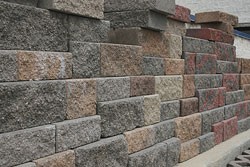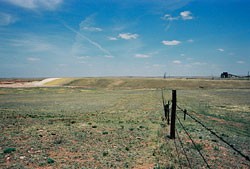Fly ash
The main byproduct of coal combustion is fly ash, a powdery material transported from the boiler by the flue gas where it is captured within fiberglass bag filters contained in Unit 1's baghouse. The fly ash is transferred to a silo adjacent to the baghouse, then transferred by large trucks to a permanent storage facility or trucked off site for beneficial use.
Bottom ash
Bottom ash comprises the coarser material that settles to the bottom of the boiler during the combustion process. It is removed from the boiler through an inclined conveyor system, then transferred to an enclosed trucking station outside the boiler facility. Once removed, the bottom ash is trucked to a permanent storage facility.
Ash storage
A state-approved monofill located on site contains most of the fly ash and bottom ash produced at Rawhide. A naturally occurring, highly impermeable clay and shale strata underlies this storage facility, inhibiting seepage.
When placed in the monofill, the fly ash and bottom ash are compacted and contoured to match the surrounding topography then covered by two feet of soil and seeded with native plants to mirror the existing landscape. Platte River uses a network of monitoring wells to continually measure water quality, and Platte River provides regular reports to regulators based on samples taken from these wells.
Regulation of disposal
Platte River environmental staff inspect the monofill weekly to confirm that approved operating procedures are followed. The Colorado Department of Public Health and Environment and the Larimer County Department of Health and Environment also conduct periodic inspections. The EPA regula tes the disposal of coal ash under the Coal Combustion Residuals Rule, published in April 2015. Information required under the new rule can be found at CCR Rule Compliance Data and Information.
Beneficial uses for fly ash
The EPA determined that fly ash is a non-hazardous byproduct of coal combustion. To save natural resources and reduce disposal and storage costs, Platte River continually seeks to find beneficial uses for fly ash whenever possible including for use in construction and industrial processes.
For example, Platte River began a program in 2007 to supply a portion of its fly ash to manufacturers of architectural block and operators of liquid waste disposal facilities. Block makers can reduce their costs and improve the strength and durability of their products by substituting Rawhide’s fly ash for a portion of the cement used in the process. By using less cement, block makers also reduce the amount of CO2 released into the atmosphere during their production process (approximately one metric ton of CO2 is emitted with every ton of cement produced). Waste management and oil field services companies also use Rawhide’s fly ash to solidify liquid waste, allowing material to be disposed with minimal hazard to land and ground water by encapsulating it.
Contact ashpurchaseinquiries@prpa.org for more information about the availability of Rawhide fly ash for beneficial uses.

